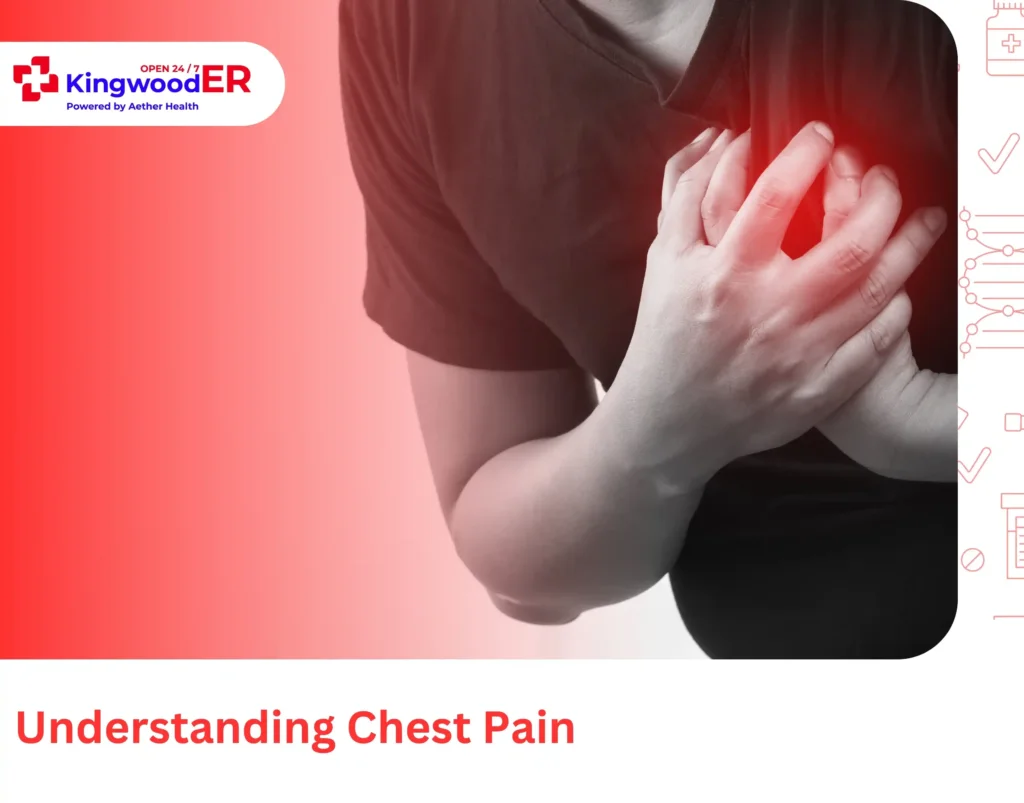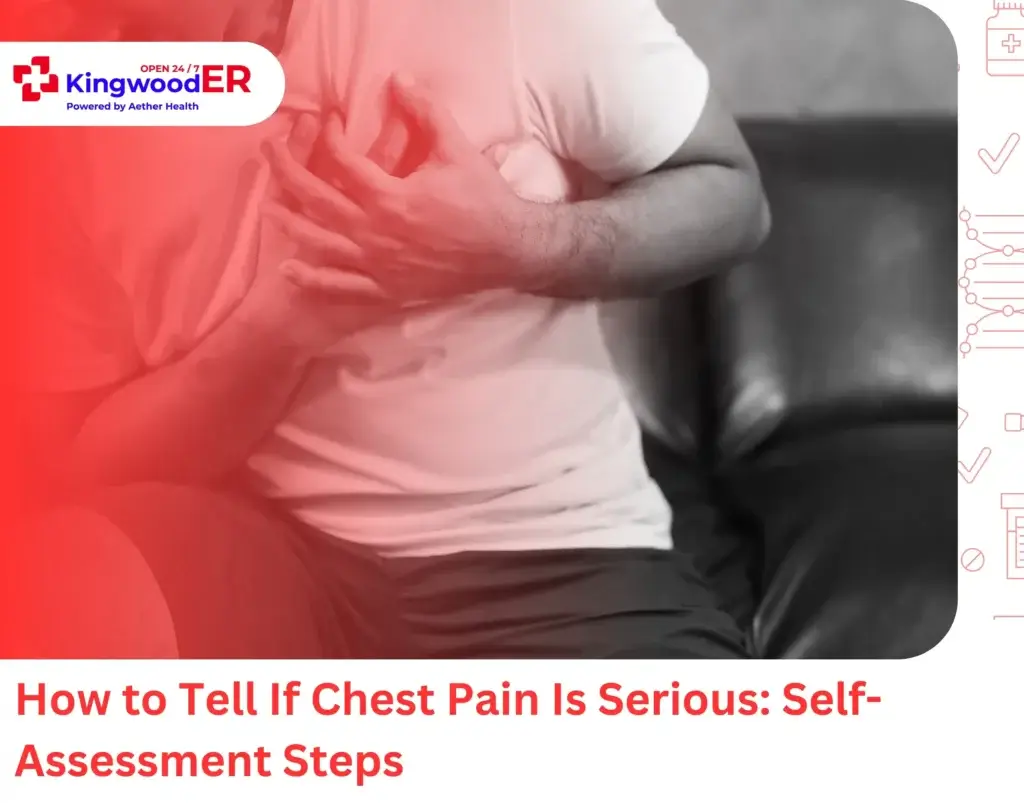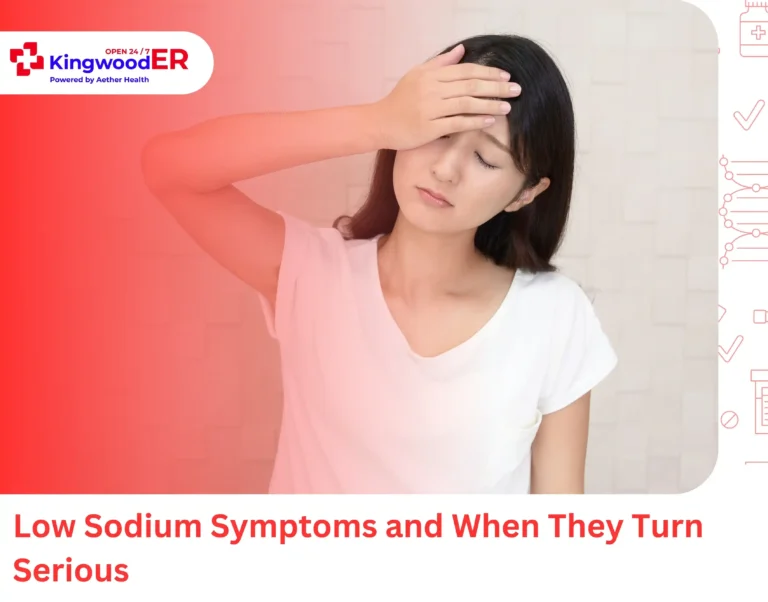Every 40 seconds, someone in the US has a heart attack. Yet millions delay seeking help due to uncertainty. Learning how to tell if chest pain is serious requires understanding specific warning signs.
Crushing pain that radiates to your jaw or arm signals immediate danger, while localized and fleeting pain often indicates non-cardiac causes. Both can feel equally frightening in the moment.
This guide explores the various types and causes of chest pain and red flags that require immediate care. It also provides clear action steps that you can take during a chest pain episode.
Understanding Chest Pain

Chest pain refers to discomfort or pain felt anywhere along the front of the body between the neck and upper abdomen. It can vary in:
- Quality: Sharp, dull, burning, crushing, or stabbing
- Intensity: Mild discomfort to excruciating pain
- Duration: Brief or persistent
- Location: Center, left, right, or radiating to the arms, back, jaw, or neck
Because multiple organs and structures reside in the chest including the heart, lungs, esophagus, muscles, and nerves, chest pain can have many causes. But only a few are life-threatening, and those are the ones that require rapid recognition.
Cardiac vs. Non-Cardiac Chest Pain
Doctors typically categorize chest pain as either cardiac (heart-related) or non-cardiac. This distinction is critical, as cardiac chest pain requires immediate intervention.
Cardiac Causes of Chest Pain:
- Heart attack (myocardial infarction)
- Angina (reduced blood flow to the heart)
- Pericarditis (inflammation of the sac around the heart)
- Myocarditis (inflammation of the heart muscle)
- Aortic dissection (tear in the aorta’s inner layer)
Non-Cardiac Causes of Chest Pain:
- Pulmonary embolism (blood clot in the lungs)
- Pneumonia or pleurisy
- Costochondritis (inflammation of rib cartilage)
- Gastroesophageal reflux disease (GERD)
- Panic attacks or anxiety
- Muscle strain or injury
- Shingles (before the rash appears)
Specific Types of Chest Pain and Their Characteristics
Understanding the typical presentations of various conditions can help assess the seriousness of chest pain:
Heart Attack
- Often described as pressure, squeezing, fullness, or pain in the center of the chest
- May come and go or persist for minutes or longer
- Frequently radiates to arms, neck, jaw, or back
- Commonly accompanied by shortness of breath, cold sweats, nausea
- May occur during rest or physical activity
- Often gradual onset, though can be sudden and intense
Angina
- Similar to heart attack symptoms but typically brought on by physical exertion or stress
- Usually resolves with rest or nitroglycerin medication
- Typically lasts 5-15 minutes
- Pattern may be predictable (e.g., always occurs after climbing stairs)
Pulmonary Embolism
- Often sharp, stabbing pain that worsens with deep breathing
- Typically accompanied by sudden shortness of breath
- May cause rapid heartbeat and feeling faint
- Risk increases after prolonged immobility or in those with blood clotting disorders
Pneumonia
- Often sharp chest pain that worsens with breathing or coughing
- Typically accompanied by fever, cough, and sometimes sputum production
- May cause shortness of breath and fatigue
Aortic Dissection
- Sudden, severe tearing or ripping pain, often described as the worst pain ever experienced
- May radiate to back between shoulder blades
- Often accompanied by sweating, lightheadedness, weakness
- More common in those with high blood pressure, certain genetic conditions, or during pregnancy
GERD (Acid Reflux)
- Burning sensation in chest (heartburn), often after eating
- May worsen when lying down or bending over
- Often accompanied by acidic taste in mouth
- May improve with antacids
Panic Attack
- Often sharp or stabbing chest pain
- Typically accompanied by rapid heartbeat, breathing difficulties, tingling sensations
- Associated with intense fear or anxiety
- Usually resolves as panic subsides
Costochondritis
- Sharp pain localized to a specific point on chest wall
- Pain worsens with movement or pressure on area
- No associated symptoms like fever or shortness of breath
How to Tell If Chest Pain Is Serious
When evaluating chest pain, several characteristics suggest a potentially serious condition requiring immediate medical attention. These include:
1. Pain Quality and Location
Potentially Serious:
- Crushing, squeezing, or heavy pressure sensation
- Pain that radiates to the jaw, neck, shoulders, back, or one or both arms
- Central chest pain (particularly behind the breastbone)
- Pain that changes with body position or breathing (may indicate lung or heart lining issues)
Less Concerning:
- Sharp, stabbing pain that worsens with movement or breathing
- Pain that can be pinpointed with one finger
- Pain limited to a very small area
- Pain that reproduces when the area is pressed
2. Associated Symptoms
Potentially Serious When Accompanied By:
- Shortness of breath
- Cold sweats or clammy skin
- Nausea or vomiting
- Dizziness or lightheadedness
- Rapid or irregular heartbeat
- Sudden weakness, particularly on one side
- Confusion or difficulty speaking
- Severe anxiety or sense of doom
Less Concerning When Accompanied By:
- Pain that changes when moving, touching the area, or breathing
- Pain associated with coughing or respiratory infections
- Pain that occurs with certain foods or after eating
3. Duration and Pattern
Potentially Serious:
- Pain lasting more than a few minutes (especially 15-20 minutes or longer)
- Pain that recurs in a pattern (like with physical exertion)
- Pain that starts suddenly and intensely
- Pain that gradually worsens over hours
Less Concerning:
- Very brief, fleeting pain (seconds)
- Pain that has persisted unchanged for days or weeks
- Pain clearly associated with movement or position changes
Table: Chest Pain: Serious vs. Non-Serious Causes
| Feature | Likely Serious (Cardiac or Pulmonary) | Likely Non-Serious (Muscle, GI, Anxiety) |
| Onset | Sudden | Gradual or after movement |
| Quality | Pressure, tightness, squeezing | Sharp, stabbing, burning |
| Location | Center or left side of chest | Localized or shifting |
| Radiation | Arm, jaw, neck, back | Rare |
| Triggers | Physical exertion, stress | Coughing, eating, anxiety |
| Relief | None or only with medication | Improves with rest, antacids, or relaxation |
| Accompanying Symptoms | Sweating, nausea, shortness of breath | None or anxiety symptoms |
Risk Factor Assessment
Your individual risk profile significantly affects the likelihood that chest pain signals something serious. Consider these factors:
High-Risk Individuals:
- Age over 40 (especially men over 45 and women over 55)
- Personal history of heart disease, stroke, or peripheral artery disease
- Family history of heart disease
- Diabetes
- High blood pressure
- High cholesterol
- Smoking or recent smoking cessation
- Obesity
- Sedentary lifestyle
- Recent long-distance travel or immobility (increased clot risk)
- Recent surgery or trauma
The more risk factors present, the more seriously you should take chest pain, even if it seems mild or atypical.
How to Tell If Chest Pain Is Serious: Self-Assessment Steps

If you experience chest pain, this step-by-step assessment may help determine its severity:
- Stop activity and rest – See if symptoms improve with rest within a few minutes
- Note the exact location and quality of pain
- Check if pain changes with breathing, position, or pressure
- Monitor associated symptoms like shortness of breath or nausea
- Consider your risk factors for heart or lung disease
- Assess duration – Track how long the pain has been present
- Try an antacid if the pain feels like heartburn (but don’t delay seeking cardiac care if symptoms persist)
Even if symptoms resolve quickly, mention the episode to your healthcare provider at your next visit.
What to Do If You Experience Chest Pain

Step 1: Stop and Assess
If the pain is sudden, intense, or accompanied by symptoms like shortness of breath or dizziness, stop what you’re doing and sit or lie down.
Step 2: Call Emergency Services (911)
Don’t wait to see if symptoms go away. Time is muscle in the case of a heart attack. The sooner you’re treated, the better the outcomes.
Step 3: Chew Aspirin (If Appropriate)
If you suspect a heart attack and are not allergic, chewing an aspirin can help by thinning the blood. But don’t delay seeking professional medical attention.
Step 4: Do Not Drive Yourself
Call emergency services rather than trying to drive to the hospital. Emergency responders can begin treatment on the way.
Don’t Second Guess Chest Pain
Never ignore chest pain, especially with heart disease risk factors or when symptoms are severe or persistent. Even medical professionals sometimes struggle to distinguish serious from benign causes without testing.
When in doubt, remember “time is muscle” in cardiac emergencies. At Kingwood ER, our board-certified physicians provide 24/7 chest pain evaluation with advanced diagnostics and no wait times. While this guide offers general insights, nothing replaces immediate cardiac assessment during chest pain emergencies.
FAQs
1. Where is anxiety chest pain located?
Anxiety chest pain is usually felt in the center of the chest, but it can shift or feel vague. It’s often not tied to physical activity.
2. Can emotional stress cause chest pain?
Yes, stress can cause chest tightness or sharp pain due to muscle tension or panic attacks.
3. Can sleeping position cause chest pain?
Poor posture or sleeping on one side too long can strain chest muscles and cause discomfort.
4. How to remove trapped gas in the chest?
Walk, stretch, drink warm fluids, or use antacids or gas relief products to remove trapped gas in the chest.




